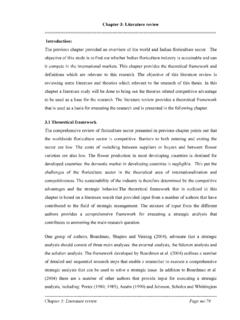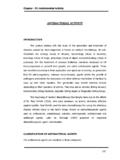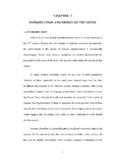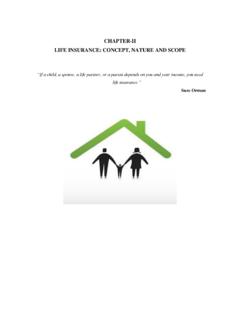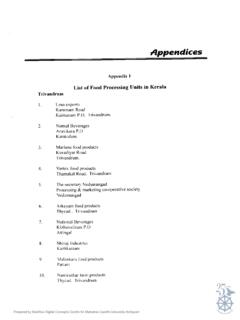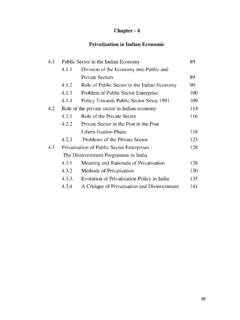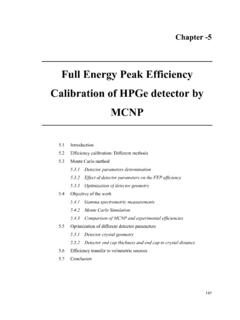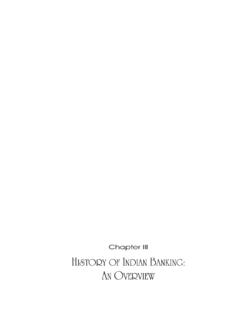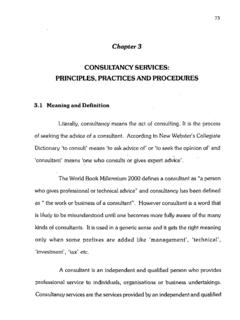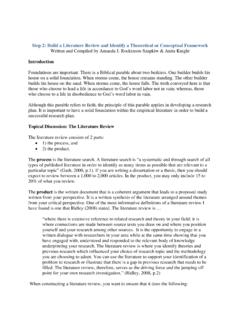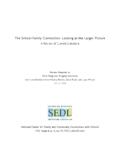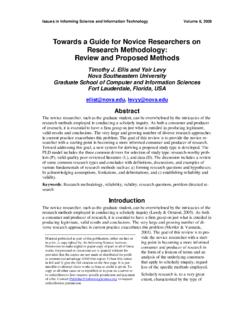Transcription of CHAPTER: 2 REVIEW OF LITERATURE & RESEARCH …
1 CHAPTER: 2. REVIEW OF. LITERATURE &. RESEARCH . METHODOLOGY. CHAPTER: 2. REVIEW OF LITERATURE & RESEARCH . METHODOLOGY. INTRODUCTION. REVIEW OF LITERATURES. What is REVIEW of LITERATURE ? Writing of LITERATURE REVIEW Importance of LITERATURE REVIEW Types of Sources for REVIEW LITERATURE Related to RESEARCH Work MEANING OF RESEARCH . DEFINITIONS. PROBLEM OF THE STUDY. RESEARCH DESIGN. OBJECTIVES OF THE STUDY. HYPOTHESIS OF THE STUDY. PERIOD OF THE STUDY. DATA COLLECTION. UNIVERSE OF THE STUDY. POPULATION OF THE STUDY. SAMPLE OF THE STUDY. SCOPE OF THE STUDY. TOOLS AND TECHNIQUES. Accounting Tools Statistical Tools CHAPTER PLAN. LIMITATIONS OF THE STUDY. REFERENCES. : 18 : INTRODUCTION: RESEARCH work traditionally defined as gathering data that can help to answer the questions about various aspects in the concern subject. The RESEARCH work may be asked to provide answers to questions of theoretical interest to particular discipline.
2 This may include such questions which have no interest to the society. The RESEARCH in social science and management are concerned with human being, which is attach to its surroundings. The organizational behavior is an important part of the focus of RESEARCH in management and social sciences and researcher must consider this part carefully to come to conclusion. The concepts of validity and reliability provide the criteria by which we need to judge our choice of RESEARCH methods. These criteria determine the credibility and academic value of RESEARCH work. RESEARCH should not considered as academic activity only, it also applies to all the respect of human activity. RESEARCH is basis for making decision effective and more meaningful. It includes the defining of RESEARCH problem, formulating hypothesis, collecting of data, analyzing of data and arriving to conclusion.
3 REVIEW OF LITERATURES: WHAT IS REVIEW OF LITERATURE ? The aim of a LITERATURE REVIEW is to show particular reader that researcher have read, and have a good grasp of, the main published work concerning a particular topic or question in specific field. This work may be in any format, including online sources. It may be a separate assignment, or one of the introductory sections of a report, dissertation or thesis. In the latter cases in particular, the REVIEW will be guided by RESEARCH objective or by the issue or thesis researcher are arguing and will provide the framework for researchers' further work. It is very important to note that REVIEW should not be simply a description of what others have published in the form of a set of summaries, but should take the form of a : 19 : critical discussion, showing insight and an awareness of differing arguments, theories and approaches.
4 It should be a synthesis and analysis of the relevant published work, linked at all times to your own purpose and rationale. WRITING OF LITERATURE REVIEW : Researcher first need to decide what he/she need to read. In many cases researcher will be given a booklist or directed towards areas of useful published work. Make sure to use this help. With dissertations, and particularly thesis, it will be more down to researcher to decide. It is important, therefore, to try and decide on the parameters of RESEARCH . What exactly are objectives and what do researcher need to find out? In LITERATURE REVIEW , are researcher looking at issues of theory, methodology, policy, quantitive RESEARCH , or what? Before researcher start reading it may be useful to compile a list of the main areas and questions involved, and then read with the purpose of finding out about or answering these.
5 Unless something comes up which is particularly important, stick to this list, as it is very easy to get sidetracked, particularly on the internet. A good LITERATURE REVIEW needs a clear line of argument. Therefore need to use the critical notes and comments researcher made while doing reading, to express an academic opinion. Make sure that: Researcher include a clear, short introduction which gives an outline of the REVIEW , including the main topics covered and the order of the arguments, with a brief rationale for this. There is always a clear link between researcher own arguments and the evidence uncovered in reading. Include a short summary at the end of each section. Use quotations if appropriate. Researcher always acknowledge opinions which do not agree with thesis. If researcher ignore opposing viewpoints, argument will in fact be weaker.
6 : 20 : LITERATURE REVIEW must be written in a formal, academic style. Keep writing clear and concise, avoiding colloquialisms and personal language. Researcher should always aim to be objective and respectful of others' opinions; this is not the place for emotive language or strong personal opinions. If one thought something was rubbish, use words such as "inconsistent", "lacking in certain areas" or "based on false assumptions". When introducing someone's opinion, don't use "says", but instead an appropriate verb which more accurately reflects this viewpoint, such as "argues", "claims" or "states". Use the present tense for general opinions and theories, or the past when referring to specific RESEARCH or experiments IMPORTANCE OF LITERATURE REVIEW : To define and limit of the RESEARCH To place your study in an historical perspective To avoid unnecessary duplication To evaluate promising RESEARCH methods To relate your findings to previous knowledge and suggest further RESEARCH A good LITERATURE REVIEW , therefore, is critical of what has been written, identifies areas of controversy, raises questions and identifies areas which need further RESEARCH .
7 TYPES OF SOURCES FOR REVIEW : 1) Primary REVIEW : Usually a report by the original researchers of a study (unfiltered sources). Letters/correspondence, diaries, memoirs, autobiographies, official or RESEARCH reports, patents and designs, and empirical RESEARCH articles. 1. 2) Secondary REVIEW : Description or summary by somebody other than the original researcher, a REVIEW article (filtered sources) academic journal articles (other than empirical RESEARCH articles or reports), conference proceedings, books (monographs or chapters' books), documentaries. : 21 : 3) Conceptual/theoretical REVIEW : Papers concerned with description or analysis of theories or concepts associated with the topic2. LITERATURE RELATED TO RESEARCH WORK: Foreign Studies The issue of efficiency in financial institutions has been the subject of considerable examination.
8 Berger and others provide a survey of the RESEARCH on scale and scope economies, X-inefficiency in banking (which describes all allocative and technical efficiencies) and the impact on efficiency of bank mergers. (Berger, Hunter and Timme,1993). The authors note the RESEARCH finding that X-inefficiencies account for around 20 percent or more of costs in banking, while scale and product-mix inefficiencies are found to account for less than 5 percent of costs. They also observe that the measured inefficiency varies considerably depending on the choice of measurement method. One interesting finding they highlight is that output inefficiencies are on average larger than input inefficiencies, which suggests that most of the inefficiencies are in the form of deficient revenues rather than excessive costs. This suggests that focusing on the cost function could understate bank inefficiency.
9 As regards the sources of X-inefficiency, the authors highlight RESEARCH findings that suggest this could be the result of agency problems between owners and managers, regulations and organizational and legal structures and scale and scope of operations. The LITERATURE on bank privatization itself is rather scanty. In one of the few studies of its kind, Verbrugge, Owens and Megginson(1999) investigated bank privatization that used public security offerings as the divestment mechanism. Their study covered 65 banks from 12 high information and 13 emerging economies, although pre- and post privatization data was available for only 36 banks, of which 31 were located in high- information economies and five in emerging economies. : 22 : The authors found limited improvement' in bank profitability, operating efficiency, leverage, and non-interest revenue after privatization.
10 There were significant returns to IPOs (although there was no information to compare these with market returns), which were consistent with those found in other non-financial privatization studies and in the IPO LITERATURE in general. This conclusion was limited to high-information economies, as pricing data for emerging economies was very limited. Seasonal issues were not significantly under priced. The authors found that the government retained substantial ownership even after the IPO;. only in seven cases was government ownership totally eliminated at the IPO stage and there were eight cases where such ownership was eliminated with a secondary offering. The authors are inclined to ascribe the limited improvement in performance post- privatization to the fact of continued government control over bank decision. Another study involves a comprehensive survey of government ownership of banks and an examination of its implications for financial development and economic growth (La Porta, Lopez de-Silanes and Shleifer(2000).)
